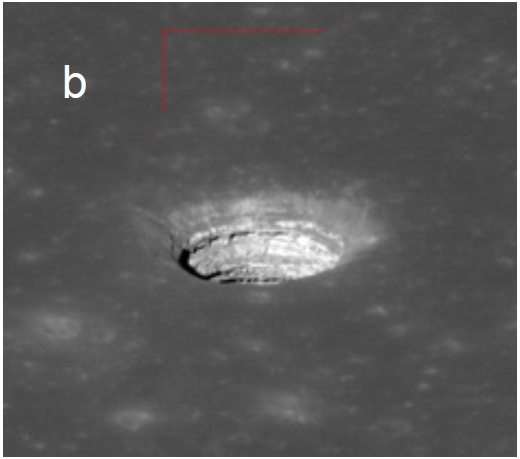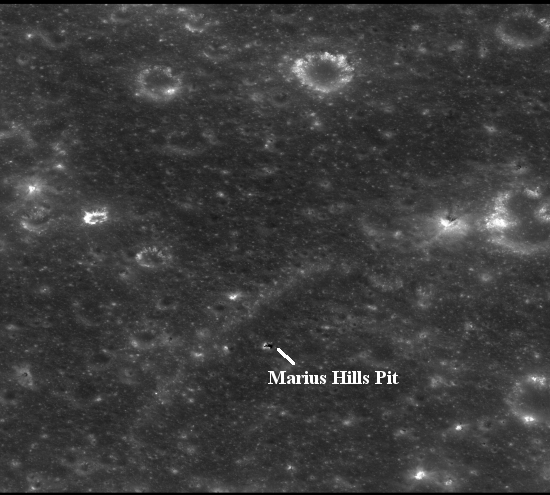The underground Moon
More images of lunar cave pits have been posted by the scientists of Lunar Reconnaissance Orbiter (LRO). They have also published their first paper [pdf] about these cave pits for the 2011 Lunar and Planetary Science Conference taking place in March. The paper summarizes, with images, what is know about the three pits on the Moon that have each been imaged a number of times at different angles and lighting situations.

- Marius Hills Pit. I have already posted the LRO images of this pit here and here and here in describing its nature and the challenges of figuring out a way to get down inside it. From the new science paper:
Images show pit diameters to range from 60 m to 47 m with a depth of ~ 36 m (~120 feet). . . . The vertical Marius Hills pit reveals a multilayered structure of near-surface mare flood basalts. Thickness estimates for the coarser units . . . have been calculated tobe 4 – 8 and 6 – 10 m (± 1 m), respectively.
- Mare Ingenii Pit. You can read a description of this pit here. I posted the discovery image of it here. From the science paper:
Its dimensions are roughly 101 by 66 m, with a depth of 60 ± 15 m. The pit walls have slopes that range from nearly vertical on the NNW side to approximately 45° on the SSE side. Rubble covers the floor in areas that are illuminated, and rises close to the pit rim, forming a ramp-like structure. The mare terrain surrounding this pit is a level cratered plain, without obvious indications of additional subsurface voids.
- Mare Tranquilitatis Pit. The science paper includes a previously unpublished 3/4 view of this pit, shown at the top of this post. According to the caption for this image,
Figure 2b is a highly oblique view of the pit, showing excellent detail within the subsurface layering and a conspicuous funnel-shaped slope to the rim. An irregular wall profile is suggestive of differential unit
strength within the layered materials, possibly resulting from intermittent emplacement of mare deposits with regolith buildup between these events.
From a caver’s perspective, it is very intriguing to look at a wide shot of the landscape surrounding Marius Hills (see below). Though according to the research paper this pit is located in a “sinuous rille” and thus likely to be associated with lava tube formation, the local landscape shows no obvious signs of other pits or depressions. The nearby craters appear to be impact craters, not sinkholes, but I could easily be wrong about this. Regardless, what this suggests to me is that many lunar caves might exist and show no telltale surface manifestations at all.

On Christmas Eve 1968 three Americans became the first humans to visit another world. What they did to celebrate was unexpected and profound, and will be remembered throughout all human history. Genesis: the Story of Apollo 8, Robert Zimmerman's classic history of humanity's first journey to another world, tells that story, and it is now available as both an ebook and an audiobook, both with a foreword by Valerie Anders and a new introduction by Robert Zimmerman.
The print edition can be purchased at Amazon or from any other book seller. If you want an autographed copy the price is $60 for the hardback and $45 for the paperback, plus $8 shipping for each. Go here for purchasing details. The ebook is available everywhere for $5.99 (before discount) at amazon, or direct from my ebook publisher, ebookit. If you buy it from ebookit you don't support the big tech companies and the author gets a bigger cut much sooner.
The audiobook is also available at all these vendors, and is also free with a 30-day trial membership to Audible.
"Not simply about one mission, [Genesis] is also the history of America's quest for the moon... Zimmerman has done a masterful job of tying disparate events together into a solid account of one of America's greatest human triumphs."--San Antonio Express-News


“The nearby craters appear to be impact craters, not sinkholes, but I could easily be wrong about this. Regardless, what this suggests to me is that many lunar caves might exist and show no telltale surface manifestations at all.”
There is an elongated depression the Marius Hills Hole is within. If you look at that picture in the article, you can see it running from lower left to upper right, and petering out about half way up the picture. In early remarks this was pointed out, and given as an indication that the lavatube involved might be as much as 350m across.
Whether that’s true or not, Oregon L5’s Research Team is happy to see those laminations in the sides of the hole. That means many events that were separate flows of lava, which probably involved the tube. That means there may be multiple layers of lavatubes, such as we have set up in the NSS (Nat. Space Society) island in Second Life. Indeed, our skylight opening has had laminations in it for some time.
Your intuition about lots of lavatubes unseen using surface indicators is shared by our Team. That is the prime reason I would like to see an orbiting ground-penetrating radar mission in close orbit around the Moon, with enough propellant to correct mascon perturbations of its orbiting free-flying receiver array till they locate all lavatubes above about 10m diameter.
IIRC, the Apollo 17 lunar sounding radar got results as deep as 6 kilometers, though it was *not* an imaging radar. IIRC, its radar wavelengths went as high as 6m. Its long wavelengths would require an even wider array of antenna elements to get a 5-10m resolution, but it would also let you do an *enormous* amount of lunar subsurface science as well as look for lavatubes to set up human dwellings within. We know radar *can* penetrate deeply enough and return, from Apollo 17’s Lunar Sounder.
Hello there everyone, I’m new on here and glad to be a part of the discussion.